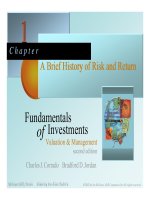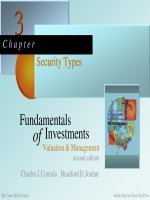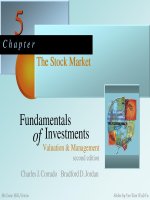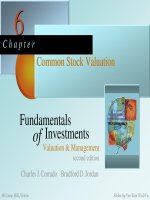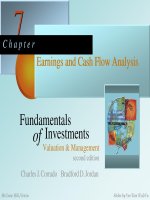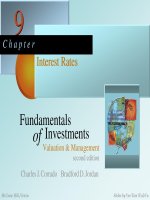Slides_Fundamentals of Investments - Chapter 6 ppt
Bạn đang xem bản rút gọn của tài liệu. Xem và tải ngay bản đầy đủ của tài liệu tại đây (1.06 MB, 33 trang )
6
6
C h a p t e r
Common Stock ValuationCommon Stock Valuation
second edition
Fundamentals
of
Investments
Valuation & Management
Charles J. Corrado Bradford D.Jordan
McGraw Hill / Irwin Slides by Yee-Tien
(Ted) Fu
© 2002 by The McGraw-Hill Companies, Inc. All rights reserved.
McGraw Hill / Irwin
6 - 2
Common Stock Valuation
Our goal in this chapter is to examine
the methods commonly used by
financial analysts to assess the
economic value of common stocks.
Goal
These methods are grouped into two
categories:
c dividend discount models
d price ratio models
© 2002 by The McGraw-Hill Companies, Inc. All rights reserved.
McGraw Hill / Irwin
6 - 3
Security Analysis: Be Careful Out There
The basic idea is to identify “undervalued”
stocks to buy and “overvalued” stocks to sell.
In practice however, such stocks may in fact
be correctly priced for reasons not immediately
apparent to the analyst.
Fundamental analysis
Examination of a firm’s accounting
statements and other financial and economic
information to assess the economic value of
a company’s stock.
© 2002 by The McGraw-Hill Companies, Inc. All rights reserved.
McGraw Hill / Irwin
6 - 4
The Dividend Discount Model
where V(0) = the present value of the future dividend
stream
D(t) = the dividend to be paid t years from now
k = the appropriate risk-adjusted discount rate
Dividend discount model (DDM)
Method of estimating the value of a share of
stock as the present value of all expected
future dividend payments.
()
()() ()
T
k
TD
k
D
k
D
k
D
V
+
++
+
+
+
+
+
=
1
)(
1
)3(
1
)2(
1
)1(
)0(
32
"
© 2002 by The McGraw-Hill Companies, Inc. All rights reserved.
McGraw Hill / Irwin
6 - 5
The Dividend Discount Model
Assuming that the dividends will grow at a
constant growth rate g,
()
() ( )
() ()
kgDTV
kg
k
g
gk
gD
V
T
=×=
≠
⎥
⎥
⎦
⎤
⎢
⎢
⎣
⎡
⎟
⎠
⎞
⎜
⎝
⎛
+
+
−
−
+×
=
00
1
1
1
10
0
(
)
(
)( )
gtDtD
+
×
=
+
11
Then
This is the constant growth rate model.
© 2002 by The McGraw-Hill Companies, Inc. All rights reserved.
McGraw Hill / Irwin
6 - 6
The Dividend Discount Model
Example: Constant Growth Rate Model
Suppose the dividend growth rate is 10%, the
discount rate is 8%, there are 20 years of dividends to
be paid, and the current dividend is $10. What is the
value of the stock based on the constant growth rate
model?
()
()
86.243$
08.1
10.1
1
10.08.
10.110$
0
20
=
⎥
⎥
⎦
⎤
⎢
⎢
⎣
⎡
⎟
⎠
⎞
⎜
⎝
⎛
−
−
×
=V
Thus the price of the stock should be $243.86.
© 2002 by The McGraw-Hill Companies, Inc. All rights reserved.
McGraw Hill / Irwin
6 - 7
The Dividend Discount Model
Assuming that the dividends will grow forever
at a constant growth rate g,
()
(
)
(
)
(
)
kg
gk
D
gk
gD
V <
−
=
−
+
×
=
110
0
This is the constant perpetual growth model.
© 2002 by The McGraw-Hill Companies, Inc. All rights reserved.
McGraw Hill / Irwin
6 - 8
The Dividend Discount Model
Example: Constant Perpetual Growth Model
Consider the electric utility industry. In late 2000, the
utility company Detroit Edison (DTE) paid a $2.06
dividend. Using D(0)=$2.06, k =8%, and g=2%,
calculate a present value estimate for DTE. Compare
this with the late-2000 DTE stock price of $36.13.
()
(
)
02.35$
02.08.
02.106.2$
0 =
−
×
=V
Our estimated price is a little lower than the $36.13
stock price.
© 2002 by The McGraw-Hill Companies, Inc. All rights reserved.
McGraw Hill / Irwin
6 - 9
The Dividend Discount Model
The growth rate in dividends (g) can be
estimated in a number of ways.
c Using the company’s historical average growth
rate.
d Using an industry median or average growth rate.
e Using the sustainable growth rate.
© 2002 by The McGraw-Hill Companies, Inc. All rights reserved.
McGraw Hill / Irwin
6 - 10
The Dividend Discount Model
Sustainable
= ROE ×
Retention ratio
growth rate
Return on equity (ROE) = Net income / Equity
Retention ratio = 1 – Payout ratio
© 2002 by The McGraw-Hill Companies, Inc. All rights reserved.
McGraw Hill / Irwin
6 - 11
The Dividend Discount Model
Example: The Sustainable Growth Rate
DTE has a ROE of 12.5%, earnings per share (EPS)
of $3.34, and a per share dividend (D(0)) of $2.06.
Assuming k = 8%, what is the value of DTE’s stock?
Payout ratio = $2.06/$3.34 = .617
So, retention ratio = 1 – .617 = .383 or 38.3%
Sustainable growth rate = 12.5% × .383 = 4.79%
()
(
)
13.36$25.67$
0479.08.
0479.106.2$
0 >>=
−
×
=V
DTE’s stock is perhaps undervalued, or more likely,
its growth rate has been overestimated.
© 2002 by The McGraw-Hill Companies, Inc. All rights reserved.
McGraw Hill / Irwin
6 - 12
The Two-Stage Dividend Growth Model
A two-stage dividend growth model assumes
that a firm will initially grow at a rate g
1
for T
years, and thereafter grow at a rate g
2
< k
during a perpetual second stage of growth.
()
()( )
()( )
2
211
1
1
10
1
1
1
1
1
10
0
gk
gD
k
g
k
g
gk
gD
V
TT
−
+
⎟
⎠
⎞
⎜
⎝
⎛
+
+
+
⎥
⎥
⎦
⎤
⎢
⎢
⎣
⎡
⎟
⎠
⎞
⎜
⎝
⎛
+
+
−
−
+
=
© 2002 by The McGraw-Hill Companies, Inc. All rights reserved.
McGraw Hill / Irwin
6 - 13
Discount Rates for Dividend Discount Models
The discount rate for a stock can be estimated using
the capital asset pricing model (CAPM ).
Discount
=
time value
+
risk
rate of money premium
=
T-bill
+
(
stock
×
stock market
)
rate beta risk premium
T-bill rate = return on 90-day U.S. T-bills
stock beta = risk relative to an average stock
stock market
=
risk premium for an average stock
risk premium
© 2002 by The McGraw-Hill Companies, Inc. All rights reserved.
McGraw Hill / Irwin
6 - 14
Observations on Dividend Discount Models
Constant Perpetual Growth Model
9 Simple to compute.
8 Not usable for firms that do not pay dividends.
8 Not usable when g > k.
8 Is sensitive to the choice of g and k.
8 k and g may be difficult to estimate accurately.
8 Constant perpetual growth is often an
unrealistic assumption.
© 2002 by The McGraw-Hill Companies, Inc. All rights reserved.
McGraw Hill / Irwin
6 - 15
Observations on Dividend Discount Models
Two-Stage Dividend Growth Model
9 More realistic in that it accounts for two stages
of growth.
9 Usable when g > k in the first stage.
8 Not usable for firms that do not pay dividends.
8 Is sensitive to the choice of g and k.
8 k and g may be difficult to estimate accurately.
© 2002 by The McGraw-Hill Companies, Inc. All rights reserved.
McGraw Hill / Irwin
6 - 16
Price Ratio Analysis
Price-earnings ratio (P/E ratio)
Î Current stock price divided by annual earnings per
share (EPS).
Earnings yield
Î Inverse of the P/E ratio: earnings divided by price
(E/P).
High-P/E stocks are often referred to as growth
stocks, while low-P/E stocks are often referred
to as value stocks.
© 2002 by The McGraw-Hill Companies, Inc. All rights reserved.
McGraw Hill / Irwin
6 - 17
Price Ratio Analysis
Price-cash flow ratio (P/CF ratio)
Î Current stock price divided by current cash flow
per share.
Î In this context, cash flow is usually taken to be net
income plus depreciation.
Most analysts agree that in examining a
company’s financial performance, cash flow
can be more informative than net income.
Earnings and cash flows that are far from each
other may be a signal of poor quality earnings.
© 2002 by The McGraw-Hill Companies, Inc. All rights reserved.
McGraw Hill / Irwin
6 - 18
Price Ratio Analysis
Price-sales ratio (P/S ratio)
Î Current stock price divided by annual sales per
share.
Î A high P/S ratio suggests high sales growth, while
a low P/S ratio suggests sluggish sales growth.
Price-book ratio (P/B ratio)
Î Market value of a company’s common stock
divided by its book (accounting) value of equity.
Î A ratio bigger than 1.0 indicates that the firm is
creating value for its stockholders.
© 2002 by The McGraw-Hill Companies, Inc. All rights reserved.
McGraw Hill / Irwin
6 - 19
Price Ratio Analysis
Intel Corp (INTC) - Earnings (P/E) Analysis
Current EPS $1.35
5-year average P/E ratio 30.4
EPS growth rate 16.5%
expected
=
historical
×
projected EPS
stock price P/E ratio
= 30.4 ×
($1.35×1.165)
= $47.81
* Late-2000 stock price = $89.88
© 2002 by The McGraw-Hill Companies, Inc. All rights reserved.
McGraw Hill / Irwin
6 - 20
Price Ratio Analysis
Intel Corp (INTC) - Cash Flow (P/CF) Analysis
Current CFPS $1.97
5-year average P/CF ratio 21.6
CFPS growth rate 15.3%
expected
=
historical
×
projected CFPS
stock price P/CF ratio
= 21.6 ×
($1.97×1.153)
= $49.06
* Late-2000 stock price = $89.88
© 2002 by The McGraw-Hill Companies, Inc. All rights reserved.
McGraw Hill / Irwin
6 - 21
Price Ratio Analysis
Intel Corp (INTC) - Sales (P/S) Analysis
Current SPS $4.56
5-year average P/S ratio 6.7
SPS growth rate 13.3%
expected
=
historical
×
projected SPS
stock price P/S ratio
= 6.7 ×
($4.56×1.133)
= $34.62
* Late-2000 stock price = $89.88
©
2002 by The McGraw-Hill Companies, Inc. All rights reserved.
McGraw Hill / Irwin
6 -
22
An Analysis of the
McGraw-Hill Company
An Analysis of the McGraw-Hill Company
An Analysis of the McGraw-Hill Company
6 -
24
An Analysis of the McGraw-Hill Company
Getting the Most from the Value Line Page
6 -
25
@2002 by the McGraw-
Hill Companies Inc.All rights reserved.

